What You Should Know About Swimmer’s Shoulder
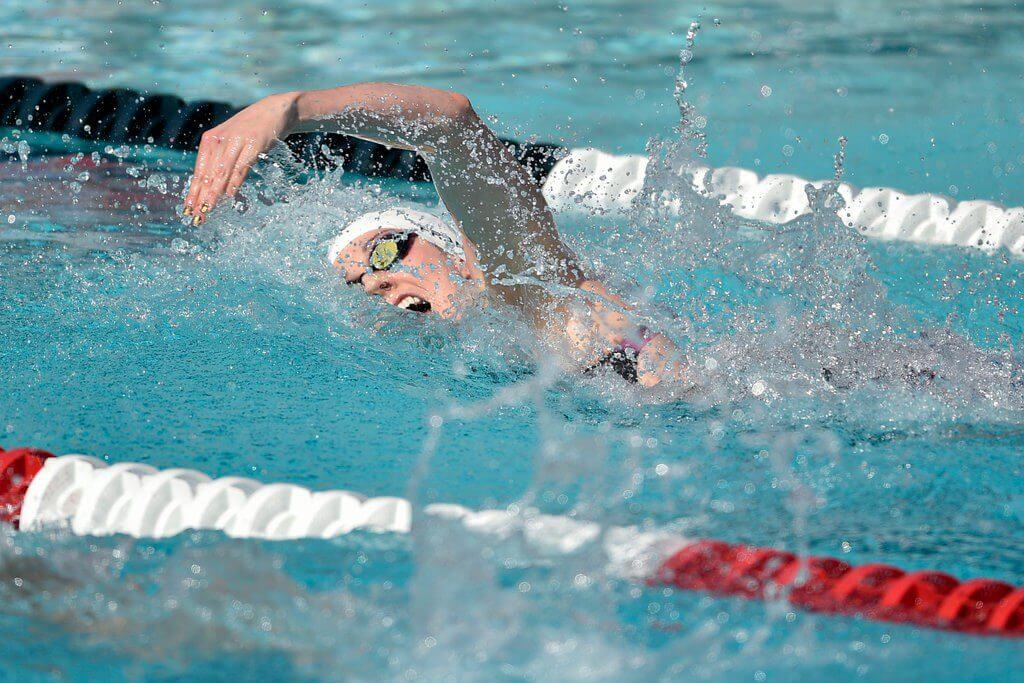
What You Should Know About Swimmer’s Shoulder
By Lianne McCluskey, Swimming World College Intern (Archived Feature)
We all know that swimmers are susceptible to shoulder injuries. Whether we have proper stroke mechanics or not, it can happen to anyone. Missy Franklin, to name one star, is an example of an elite athlete and Olympic champion who dealt with regular shoulder issues.
The title “swimmer’s shoulder” is a general term for a variety of impairments that can develop in the shoulder of a competitive swimmer. Without getting too technical, it’s helpful to understand the shoulder movement of the competitive swim strokes at a biomechanical level.
The shoulder joint is a ball-and-socket joint with movement in all three planes and around all three axes of the body. It is one of the most moveable joints, making it one of the least stable.
Swimming requires several different shoulder motions, most of which are performed during circumduction in clockwise and counter-clockwise directions with varying degrees of internal and external rotation and scapular protraction and retraction. Arm strokes are divided into two primary phases: pull-through/propulsion and the recovery.
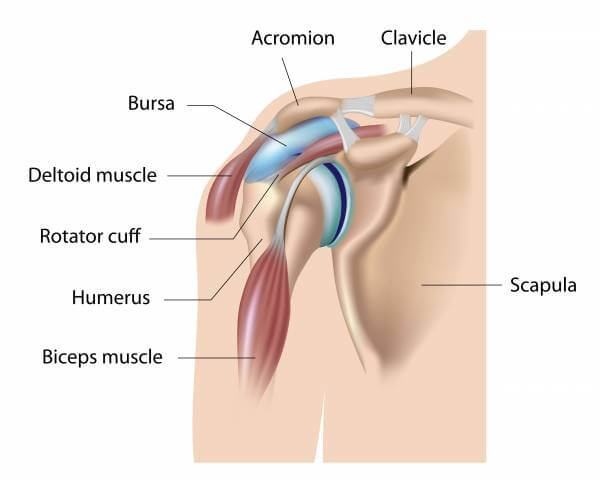
Photo Courtesy: Bond Clinic, PA
As stated in a research study on prevention and treatment of swimmer’s shoulder by Brian J. Tovin, the shoulder complex is designed to achieve the greatest range of motion (ROM) with the most degrees of freedom of any joint system in the body. For swimmers, this means there needs to be a balance between shoulder mobility and stability.
Swimmer’s shoulder is classified as a microtrauma, a condition with a gradual onset due to repetitive activity over time. There are multiple factors that can come into play regarding the development of swimmer’s shoulder. The onset of symptoms may be associated with impaired posture, glenohumeral joint mobility, neuromuscular control, or muscle performance. Overuse, misuse, abuse or disuse over time during training may also contribute to this condition.
Intrinsic Factors
Many overhead sports such as throwing, racket sports, and volleyball require two or three overhead movement patterns. In swimming – due to the change in demands of the glenohumeral joint – impingement can occur, stressing the tendons of the shoulder. Swimmer’s shoulder most commonly presents as subacromial impingement involving the rotator cuff tendon, bicipital tendon, or subacromial bursa. Muscle fatigue is often the cause of injury in these cases; it’s not necessarily because the motion has been done improperly.
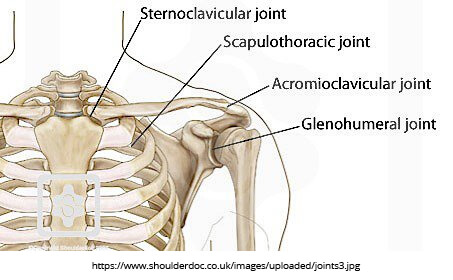
Photo Courtesy: PhysioHealth
Extrinsic Factors
Extrinsic factors are the impairments in stroke technique that contribute to the shoulder injury. A clinician must determine if the microtrauma is due to overuse, misuse, abuse or disuse in swimming. Excessive body roll with arms crossing the mid-line is a common error that leads to shoulder impingement. Lack of body roll also can cause pain, since the humerus compensates by moving into further horizontal adduction to create adequate propulsion to move forward. Excessive force of the shoulder tissue can also abuse the shoulders and lead to shoulder pain.
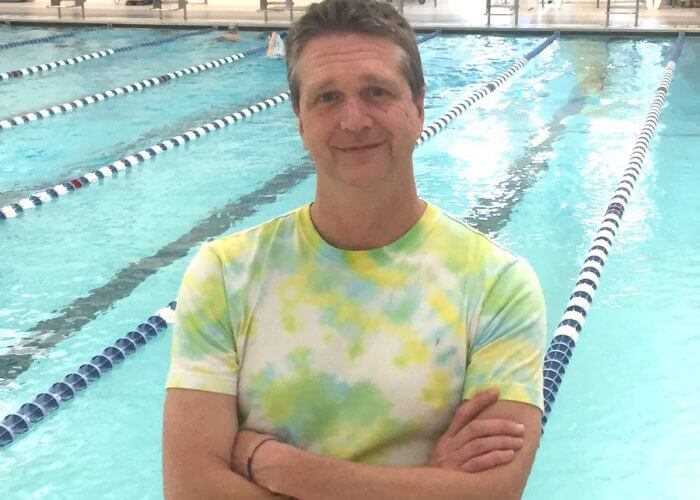
Photo Courtesy: Hodding Carter, current head coach at Camden Hills Regional High School.
How do we avoid and treat swimmer’s shoulder?
“I think ninety percent of the time, real shoulder issues can be avoided or treated through technique changes,” says former competitive swimmer and current swim coach Hodding Carter. Carter swam for Kenyon College and has since performed at the national level in U.S. Masters Swimming.
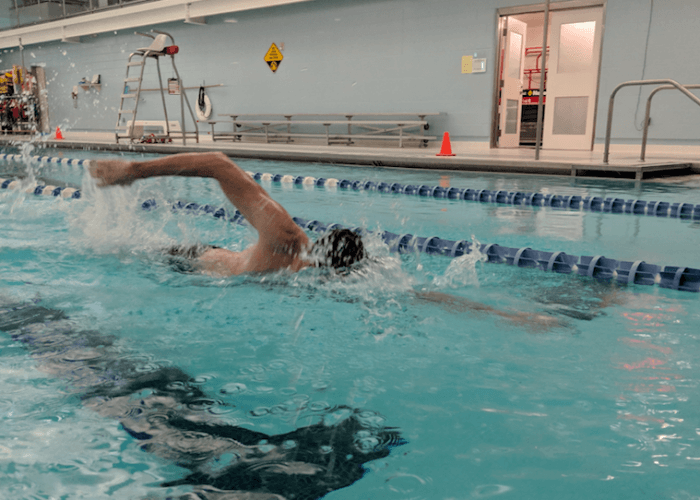
Photo Courtesy: Lianne McCluskey
Carter adds:
Besides trying to focus on whole-body swimming – mainly meaning core and hip timing – when a swimmer has or looks like he or she is headed toward shoulder problems, we focus on technique fixes. Many times it’s as easy as stopping a swimmer from turning his or her palms out at the beginning of the catch or similar mistakes that lead to shoulder problems.
Swimming World did a Q&A with Dr. Angela Tate on swimmer’s shoulder, where she gave her opinion and advice on the condition based on her experience as a physical therapist working with competitive swimmers.
Whether you’re training for Olympic Trials or your next dual meet, prehabilitation of the shoulder can prevent unforeseen injuries and assist in achieving optimal swimming performances.
All commentaries and research was conducted by the the author and do not necessarily reflect the views of Swimming World Magazine nor its staff.




Aislinn
I had my shoulder joint completely replaced and I’m back in the pool. Swimming backstroke is a little hard and butterfly is out of the question.
Thomas, I would be interested to hear updates on your progress. I was advised that shoulder replacement is an option but (as a flyer) I’m concerned about the restrictions. Even with pain level and reduced training, somehow I tied Rowdy Gaines in the 50 fly (LCM) this year. That & $5 will get you a coffee…. lol
Lily Jenkins
This is why I had to retire back in the day. At the turn of the year from ’87 to 88, my left shoulder was in such a state that I couldn’t even go for super-easy recreational swim for 10 years afterwards ??
Tomas Thrainsson what was your stroke?
Got a couple of backstrokers in the family, just curious.
I started out as a long distance, then moved into the IMs, especially the 400m and also 100 and 200 breast. A very gradual transformation though.
200 free, I wasn’t very good at, but my personal best of 1:58 had a 59-59 split and my best ever 100m free was a 57,7.
I would like to think my shoulder inhibited me quite severely, as I never could really get up any special speeds on any discipline.
1500 free I made it to 17:15, and then the shoulder caved in for good and I never got back to it.
Lacey Lorraine Radloff very interesting read.
Taylor García
Ailbhe Martyn be worth pointing this out
Joe Bergin ?
A great piece of simple to understand knowledge about swimming ???
Joni, Brenda… some light reading!
Angel Ciruela Pitao-Raguindin
Jennifer Mars
Good read xoxo
Warm ups and dry lands should be review by doctors who specializes in swimming. Swimmers are different and need notifications to protect the shoulders.
My son is a competitive swimmer and I worked as the team chiropractor for the 49ers I now seem to see many patients with “swimmers shoulder” and many of the points addressed are true as it relates to types of injuries commonly seen but I do not believe that 90% of shoulder injuries can be prevented by technique changes. The athlete needs to understand the progression of insult to the tissue involved. Repetitive stress on the anterior component of the shoulder will eventually cause irritation and inflammation to the connective tissue most commonly affecting the tendons causing a tendonitis. The body
compensates and puts down scar tissue in the form of collagen to remodel. This tissue is placed down in an erratic way and can lead to more friction resulting in a bursitis. If the athlete continues to abuse or override their symptoms the inflammation may be driven internally into the shoulder causing a capsulitis. This is denoted when the patient or athlete is unable to sleep on their shoulder. If this is allowed to continue without care it may eventually scar the Glenohumeral joint and lead to impingement syndromes (usually posterior) As you can see the progression of insult to the tissue is what needs to be addressed. There are three main principles to avoid injury and promote healing if symptoms progress. #1 increase mobility of the joint which may be achieve through specific stretches. I like anterior capsule stretch and pectoral stretches in different planes. #2 increase stability of the joint. The swimmer is often using a single plane of movement and primarily activating larger muscle groups in the shoulder that are over active. Smaller muscles such as the infraspinatius and Teres minor are needed to balance the larger muscles such as the pectoral muscles. This can be achieve with light green tubing (external rotation). #3 proper body mechanics. This is not only achieved with swimming but also dryland. (Not 90%) Overhead lifting can cause extreme impact on the shoulder joint. A proper dryland program should incorporate multiple planes of movement in order to develop the muscles of the shoulder completely. For example the pec muscle should be developed with emphasis on upper mid and lower with no less that 3 different exercises for each plane. This will take stress off a single muscle that may have a tendency to be overuse. My advise is to see a sports medicine practitioner that knows how to break up scar tissue and knows how to stop the progression of injury before it gets to the surgery stage. In other words…Don’t Override Your symptoms! I alway tell my athlete if you noticed your symptoms continue to increase as you are performing. It’s time to stop and seek treatment. I hope this advise helps ?
Swimmingly
John Pellegrini thank you. Very sensible and good advice.
Between the 60’s & 70’s Passive stretching for the shoulder joint was performed in excess in swimmers who were already hypermobile & coaches/swimmers thinking they were preventing injury were actually part of an epidemic of injuries. There are still those who do not understand that static stretching immediately prior to competition will decrease performance. The progression of training & the use of dry-land programs, including stretching, should be specific to the individual athlete. My experience at an Olympic level taught me that talent is no guarantee of knowledge.
If only I had known then what I know now….both of my older kids were swimmers and developed shoulder problems. Daughter had to quit as a sophomore. Heartbreaking. We just didn’t understand and let it go too long. Crazy how many high level, reputable coaches look at you like, “beats the heck out of me” when you ask them why shoulders might hurt. My youngest (12) still swims and I’ve got an eagle eye for it now.
Mary Dunnigan Crow Yes I agree. I actually have my USA coaching credentials for swimming and there is really not much in training as it relates to shoulder injuries. Parents are often told not to allow their kids to strength train because they are too young. Although I will agree that workouts should be age appropriate. What parents don’t realize is that their children are working out every-time they go to practice. If your child is going to participate in year round sports it is only a matter of time that they will suffer from a repetitive injury. I see it happen in all sports that are year round. Knowledge is power. From my experience in swim most swim clubs do not adequately address dryland stability training. The dryland time is often limited due to time constraints.
Amalie Kærgaard
I am not sure that the shoulder was ‘designed’ as this article states.
I think it has evolved into the complex joint that it is today.
Akiane
Kimberly Bimber Smith read this
David Olvera
Zeke Pine
For more information google supraspinatus, supraspinatus tendon, rotator cuff
Swimmer’ Shoulder has absolutely nothing to do with the shoulder!!! I wish I’d have seen Missy before she ever had surgery, let alone retired!!
Stephen Tomlinson you make up good graphics ?
Thanks buddy….you know me, I like it simple ?
Stephen,
Grateful for you. I was starting to get frustrated. The issue is NOT the shoulder and swimmers are already hyper mobile in the shoulders so stretching them more is not going to make things better in fact most likely will make them worse. You need to look at other areas of the body, starting with the thoracic spine, to see who is not coming to the party. Most shoulder surgery can be and should be prevented given we treat the whole body based on the need of the swimmer/athlete and not just the area of pain.
Just what I wanted to read on the day I start another come back!
Jared Spitz read article and comments.
Warren Mann
Connor Brunt is this your way of telling me if i dont get some tissue work done my shoulders will explode? Either that or to man up?
Yvonne Ruff
William Fitzpatrick Paddy Doran
Rachel Henry
Sydnie Saddoris